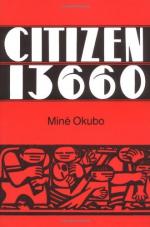|
This section contains 492 words (approx. 2 pages at 400 words per page) |

|
Citizen 13660 Summary & Study Guide Description
Citizen 13660 Summary & Study Guide includes comprehensive information and analysis to help you understand the book. This study guide contains the following sections:
This detailed literature summary also contains Topics for Discussion on Citizen 13660 by Miné Okubo.
Citizen 13660 is an autobiographical and historical account of Japanese-Americans forced to relocate to camps during World War II, seen from the eyes of one of the evacuees, author Mine Okubo.
Through a combination of drawings and captions, Mine tells her story. She is in Europe on an art fellowship when England and France declare war on Germany. The French border is closed, and Mine must wait many months with her possessions in another country until she can board one of the last refugee ships out of Europe for New York.
From New York she rides to California, where she spends some peaceful months with her family until December 7, 1941, when Pearl Harbor is attacked. About a week later, the United States declares war on Japan, and many Japanese-Americans become the targets of racial hatred and suspicion. Paranoia about the possibility of spies and saboteurs among the Japanese-American population prompts the government to forcibly evacuate Japanese-Americans living on the west coast to more than a dozen relocation camps. Mine evacuates with her younger brother to Tanforan Assembly Center, a converted horse racing track.
Much of the book is concerned with the everyday life of evacuees. Evacuees must deal with harsh living conditions (dilapidated barracks, straw mattresses, poor food and water, exposure to the elements), lack of privacy (communal toilets and showers, cramped living quarters) and, more than anything, the indignity of living as a prisoner, being inspected, searched, confined, and sometimes treated little better than animals.
Mine is able to see the positives that spring from these negatives. Evacuees become very resourceful, furnishing barracks with scrap-lumber, making arts and crafts from whatever is at hand, and improving their own living conditions when the government cannot or doesn't care to. Despite their confinement, evacuees do their best to function as a normal society, taking on jobs, indulging in recreational activities, learning musical instruments, and having weddings and funerals.
Mine, as other evacuees, learn to live the best they can considering their circumstances. She is transferred to another facility in Utah, called the Central Utah Relocation Project near Topaz. Facilities are better and more numerous, and overall the camp is more livable than Tanforan, indicating the hard work of the evacuees and the fact that the government is becoming better at administrating the camps.
Eventually rules become relaxed, and people begin to leave the camps in various ways. Some leave as soldiers, though a questionnaire affirming the allegiance of evacuees to the United States angers some residents. Some leave as seasonal workers, or as students going to college. Mine's own brother goes to work in a factory and eventually the army. Eventually, having finished her documentary project of sketching, leaves the camp. She is saddened to see the (mostly) very old and very young she is leaving behind, wondering how the government expects these people to leave a place they have called home for years. She tries to look to the future.
Read more from the Study Guide
|
This section contains 492 words (approx. 2 pages at 400 words per page) |

|



